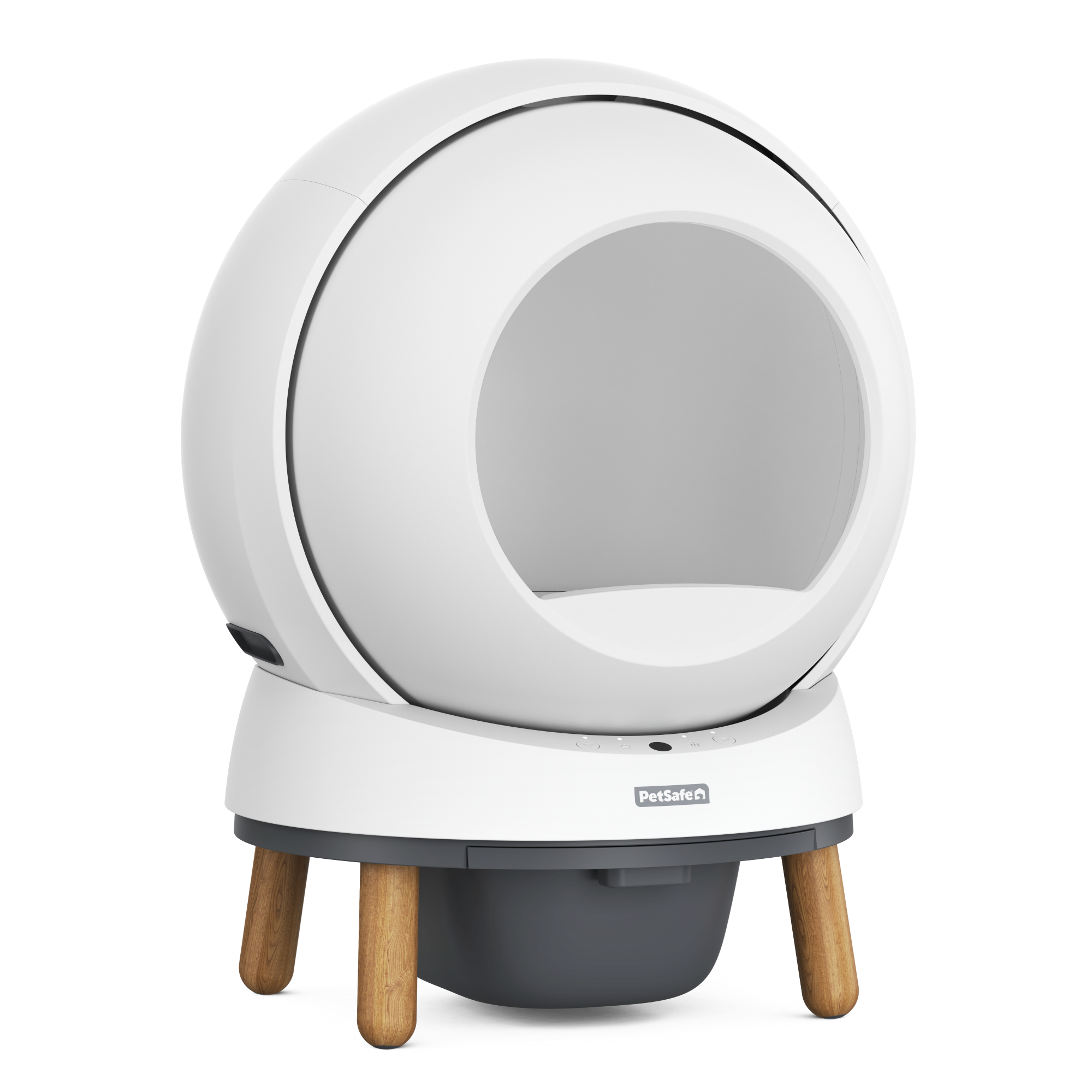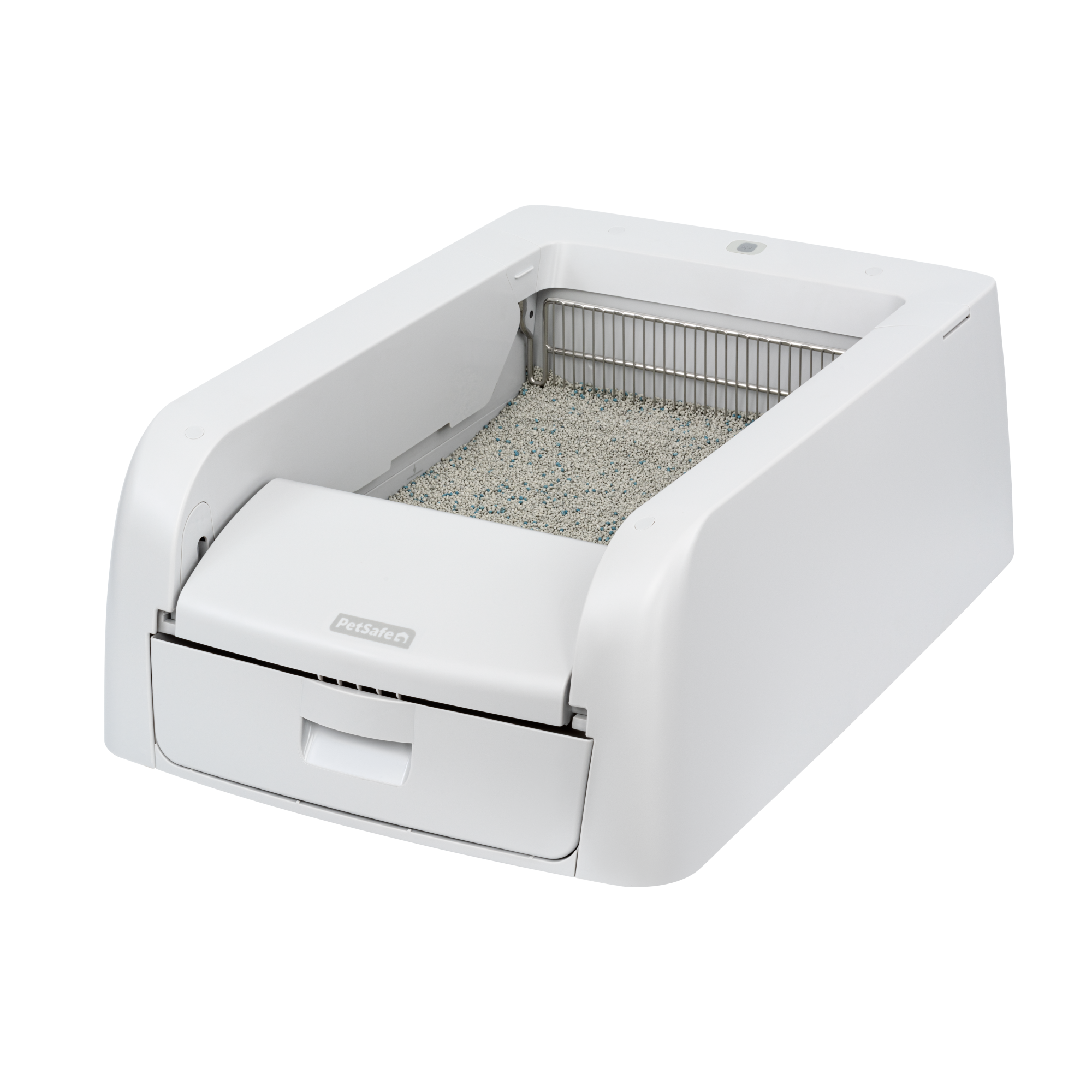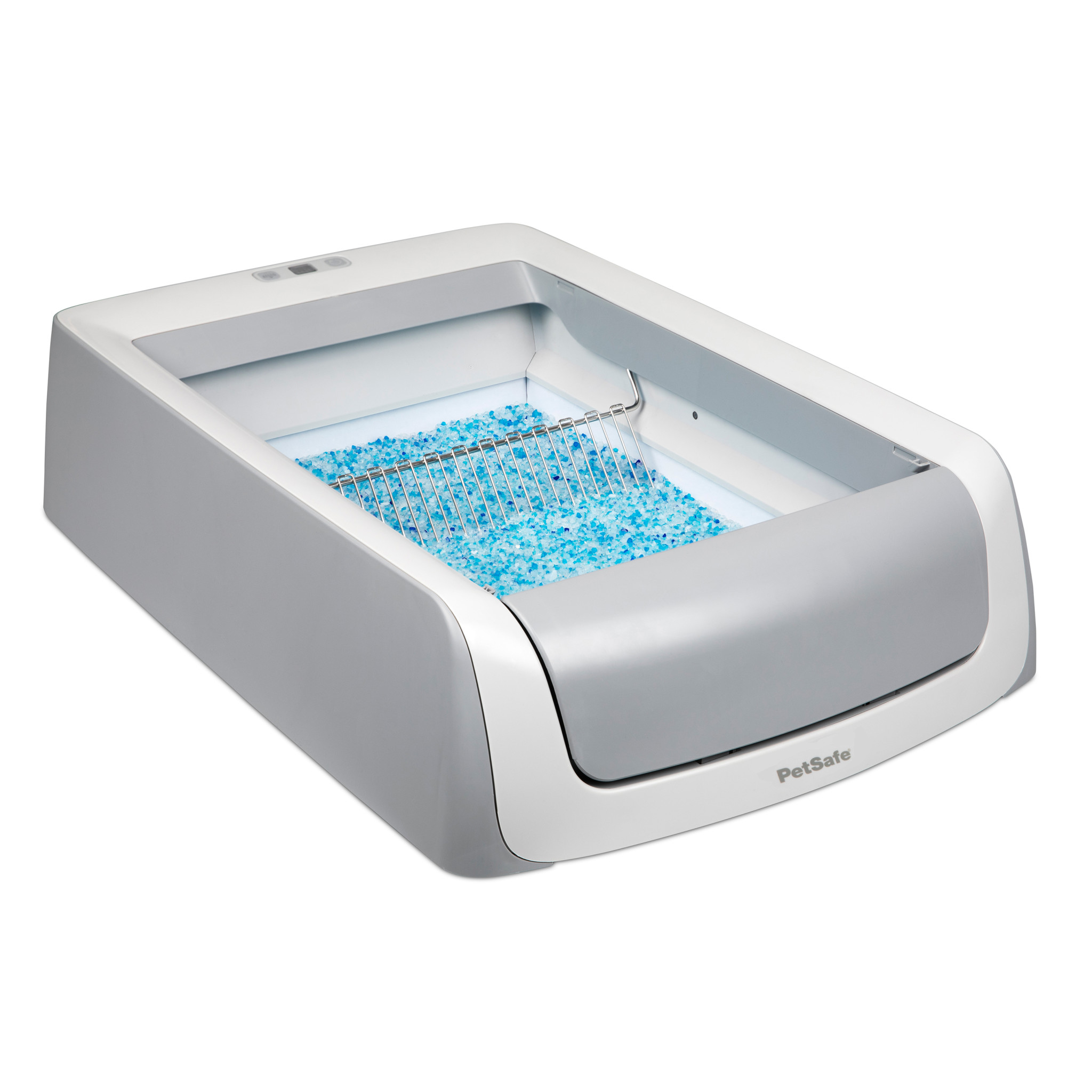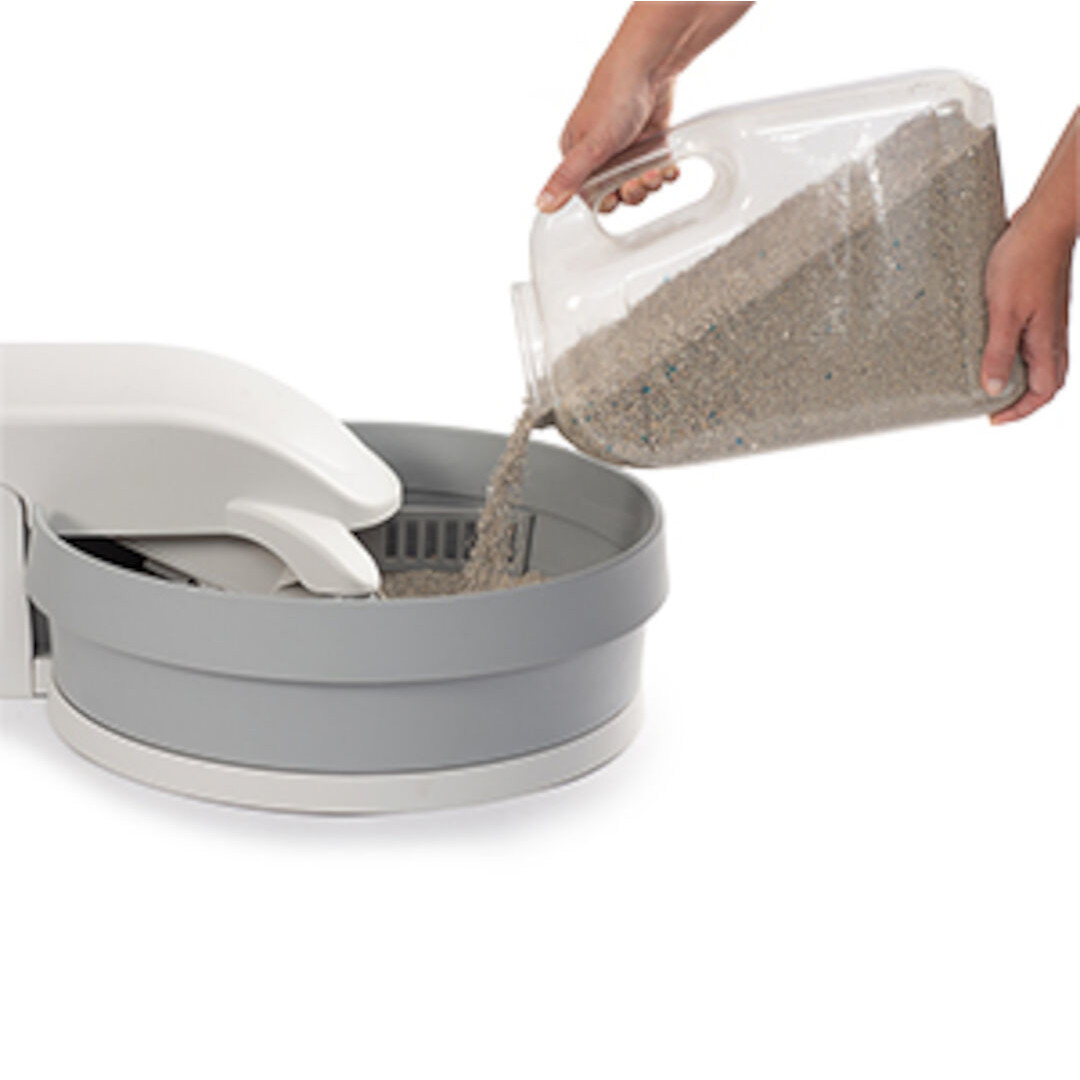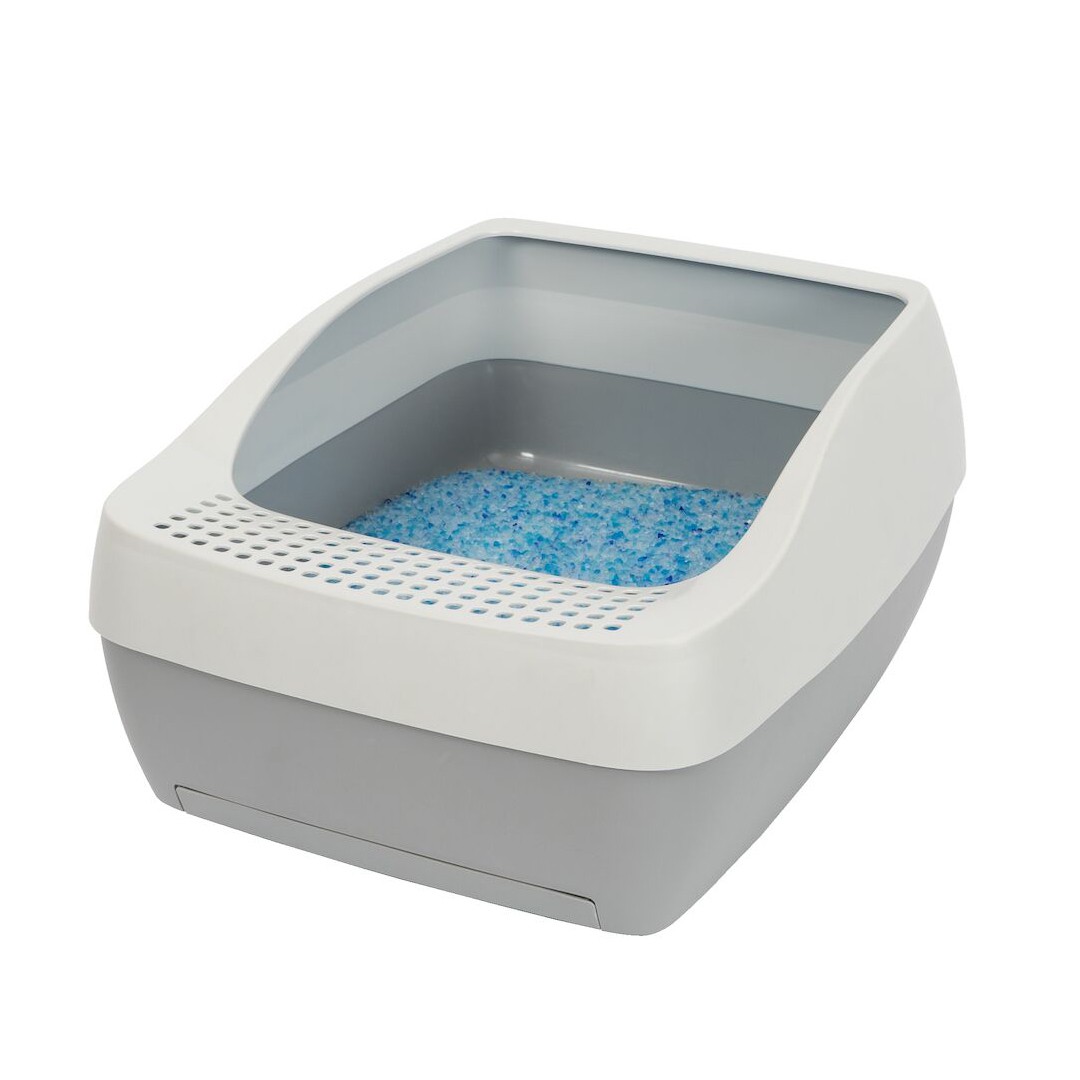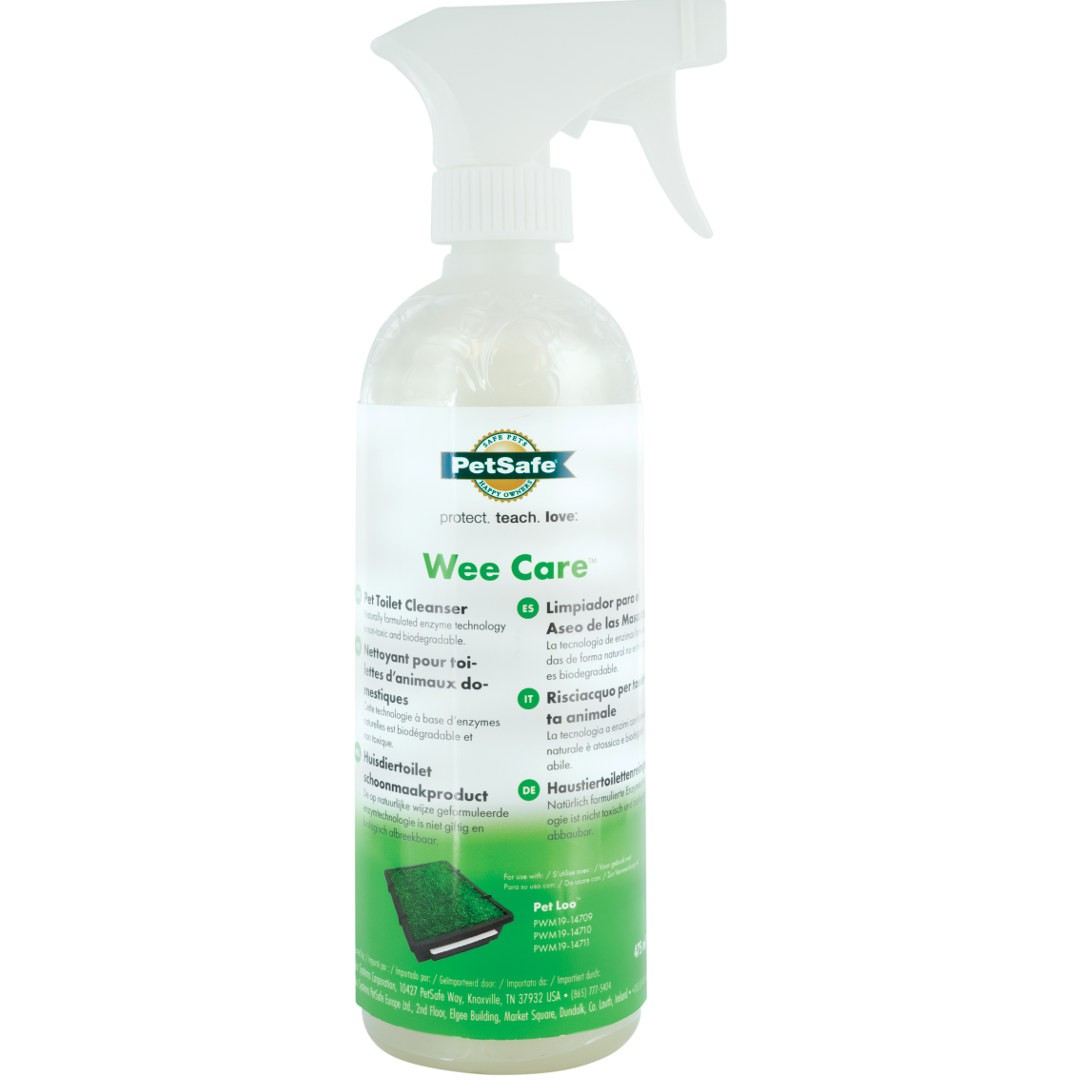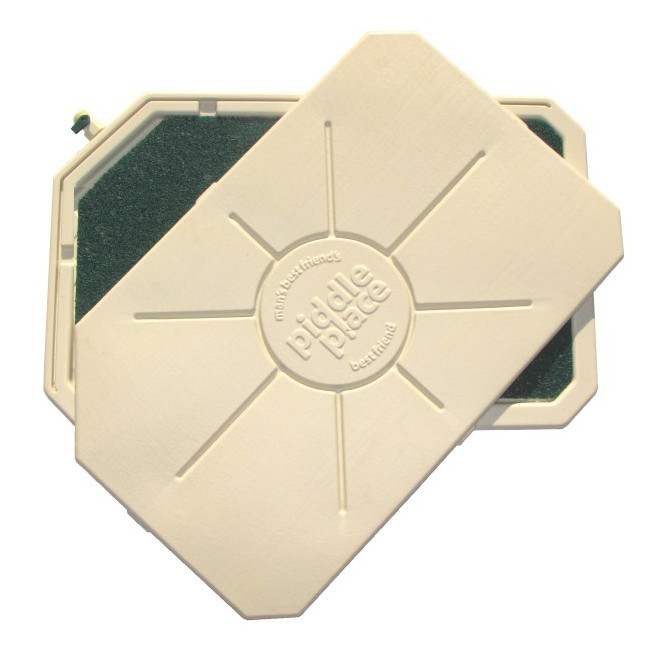For manuals & product support, start typing the name of your product here. You can also browse by category and product below.
Register your product so you get the most out of your warranty and so we can assist you better if you call in for phone support.
Animals learn by association, so you’ll need to adapt what your cat is peeing on now to the litter box in small, slow steps. If at any time your pet goes backwards a few steps, this is an indication you're pushing him/her too far too fast. Slow it down or even back up a stage or two, then try again, but at a slightly slower pace. Your pet only wants to make you happy, so continual praise and reward is the key!
If your cat is peeing on an object such as a small area rug or box:
If your cat is peeing in a specific spot such as a corner or wall:
Either your pet’s routine has changed or something in the environment has changed.
If an action is followed by praise or reward, after a period of time, an animal will learn to repeat this action. Training an older dog may take a little more time and patience, but if you invest the time, you will reap the rewards. Some dogs may instantly get it from the word “Go,” while others may need a little extra help. You’ll need to put in some serious time and effort to have a fully house trained dog, but it will be rewarding in the end!
Basic Steps
Frequent Potty Breaks
Before launching into the epic adventure that is toilet training a dog or pup, it can help the process if you put yourself in their shoes.
An 8-week-old puppy, when awake and active, will need to need to go on average about every 20-40 minutes, or after every meal and after every nap. Puppies don't start gaining control of their bladder and bowel functions until they are several weeks of age. This is also the age when puppies start developing preferences for where they will go - a vital stage for learning to go where you want them to go.
Many puppies need 15 minutes of sniffing and circling before they are comfortable enough to go. The sniffing and circling is very important, but this should not become playtime. Keep toys and distractions away from where your pet goes to the bathroom.
Always Supervise
One of the biggest problems with toilet training is not supervising your pet. If your dog has accidents in the house, and if this is allowed to happen often enough, the pup will soon be conditioned to toilet inside, wherever he likes. It’s important to supervise your dog before he’s properly house trained.
When you can’t watch your pup, keep him in a safe, confined area such as the laundry room, bathroom, crate or anywhere with an easy-to-clean floor. This makes accidents easy to clean up, and your dog will be more likely to choose the Pet Loo™ Pet Toilet or pee pad to toilet on, rather than their eating or sleeping spaces.
Be Consistent
The key with toilet training is consistency. Much like humans, all dogs are different, so you may need to adapt your training methods to suit your best friend. Whichever approach you choose, it's important that you stick to it! Toilet training can take up to 2-3 weeks, so don’t give up!
Clean It Up
Clean up accidents with good quality cleaning products that get to the source of the smell and prevent pets from using that spot again. Liquid, enzyme-based products, such as Liquid Ate™ Stain Remover & Odour Eliminator, get to the source of odour or stain to eliminate, not cover up.
Potty Training Tips
The issue you're facing is "surface association" because your dog is trained to go on a unique surface not found in your garden. Your pet is looking for that pad or paper when out on the walk or in the garden.
You can easily transition your pet to use grass by using the Pet Loo™ Pet Toilet. Simply place the Pet Toilet in the area where you normally place pee pads or newspaper, then put the pad on top. Each time you need to replace the pad, cut it in half so that more and more of the Synthetic Grass can be seen underneath. Eventually your pet will not need the pad at all and will just be using the Pet Loo™ Pet Toilet.
If your dog is reluctant to step up on the Pet Loo™ Pet Toilet during this initial stage, you can use a similar technique. Take the Synthetic Grass off the base unit and place the pad/paper on top of the grass and on the ground in the area that your dog prefers to toilet. After a day or so of successfully using the grass and paper combination, you can then introduce the base unit to your dog by placing it next to the Synthetic Grass.
Give your dog another day or so before placing the grass and paper back on top of the Pet Loo™ Pet Toilet. Once your pet is confidently using the Pet Loo™ Pet Toilet, you can start halving the pad on top of the grass.
There are products available that help you train your pet to go to the bathroom. Pets are instinctively territorial, so if they smell the scent of another dog's urine, they will be inclined to mark on it. Skip to My Loo™ Attractant & Toilet Training Aid is a unique attractant that helps you toilet train your best friend. The scientifically formulated solution mimics animal urine and encourages your pet to use that spot, making potty training easy.
Using the litter tray for more than 30 days per cat may result in urine leakage and tray breakage.
ScoopFree was designed for use with one or two cats. If you have more than two cats, you will need one litter box for every two cats.
Blue crystal litter trays are 36.83 cm x 57.15 cm x 6.35 cm. Clear crystal litter trays are 55.88 cm x 38.10 cm x 6.35 cm. The usable litter bed area is 35.5 cm x 35.5 cm. ScoopFree Clear litter trays do not include lids and can be nested, allowing them to be stored in a smaller space.
ScoopFree's litter bed measures 35.5 cm x 35.5 cm, and the exterior litter box dimensions are L 69.5 cm x W 48.2 cm x H 17.8 cm.
When the litter is saturated or the waste trap is full, simply place the cover on the used litter tray and throw it away. Replace the used litter tray with a new one.
To extend the life of your litter tray, do not put any litter underneath the waste trap lid when you pour the litter into the tray. Some people find that mixing the crystal litter once a week also extends the life of the tray. This is extremely beneficial if your cat is ill or has high urine output. It will also benefit cats that do not cover their waste or urinate consistently in the same spot. Be sure to mix the crystals from behind the rake and along the sides of the litter box. Do not mix the litter in the waste trap.
Setup is easy. Simply lift the litter box and slide in the disposable litter tray filled with Premium Blue crystals litter for unbeatable odour control.
We recommend replacing the litter tray every 20 - 30 days for one cat, every 10 - 15 days for 2 cats, or every 7 - 10 days for 3 cats. You may need to replace the litter tray more often if you have: cats who eat a diet high in crude fiber, ash, and byproducts; cats over 10 years old; cats with health problems; and kittens under 6 months old.
ScoopFree is rigorously tested in our lab for more than 100,000 cycles without failure or jamming.
You should change the tray when either of the following occurs:
Remove the four green plastic shipping inserts on the bottom of the litter box. The rake should work correctly after you remove and discard these inserts.
Some cats may require an adjustment period to get used to a new litter box. Here are a few tips to help with the transition.
ScoopFree has proven to be very safe in testing. Here are the standard safety precautions:
The rake will not sweep if a cat is in the litter box because it will be obstructing the infrared sensors. The countdown timer will reset itself, so the rake will begin to sweep 20 minutes (or 5, 10, or 20 if you have ScoopFree Ultra) after your cat leaves the litter box again.
ScoopFree Original and Ultra are automatic; they automatically sweep waste after your cat uses the litter box. They have the same outer dimensions and useable litter bed space. ScoopFree Ultra functions like the original ScoopFree with three additional features for the ultimate in cat care:
The Premium Blue litter tray comes preloaded with Premium Blue Crystal Litter that stops odor 5 times better than clay and clumping litter. All Premium Blue litter trays come with a lid. When the tray is ready to be disposed, simply cover it and dispose of it.
The Scent Free Crystals Litter Tray is made from recycled materials (paper with no bleach added) and comes pre-filled with premium crystal litter free of perfumes and dyes. Free trays do not come with a lid so the trays nest, making them easier to stack and store in small spaces.
They're available online and from leading pet speciality stores.
All ScoopFree litter trays work with all ScoopFree litter boxes..
Cats over 10 years old tend to be prone to kidney issues which account for increased urine output and decreased litter tray lifespan.
The green indicator light flashes for two reasons:
ScoopFree needs little cleaning because the parts most likely to get dirty are part of the disposable litter tray, which is thrown away. If you do need to clean the ScoopFree unit, follow these steps:
Do not immerse ScoopFree in water, spray it down, or expose it to excessive sunlight or moisture.
Most cats adapt easily to the ScoopFree® box and use it within a week. If your cat needs help adjusting, try these tips:
• Leave your cat's old litter box next to the ScoopFree® litter box.
• Add a few handfuls of your cat’s old litter to the ScoopFree® litter tray and add a few handfuls of the ScoopFree® crystal litter in your cat's old litter box.
• Stop cleaning the old litter box. As the old litter becomes shallower and dirty, your cat should start using the cleaner ScoopFree® litter box.
• If your cat is startled by the raking noise, turn off the ScoopFree® box and scoop waste manually for a few days until your cat is used to the new litter box.
If you have a kitten under 6 months old, we recommend leaving the litter box unplugged and scooping waste manually. You can start getting her used to using the litter box with these tips.
• Kittens have a natural reflex to use the bathroom after eating, playing, or napping. Put your kitten in the litter box after these activities to help her associate the litter tray with the instinct.
• Place the litter box away from the food and water bowl. Cats prefer not to use the bathroom near where they eat and drink.
• Put the litter box in a quiet, visible place where she can get to it quickly. Getting all the way across the house to find the litter box could result in accidents. The location should also be safe and quiet so your kitten won't be startled or distracted.
• Keep the litter box clean. Scoop waste often and change the litter tray every few weeks. Cats and kittens prefer a clean litter box.
• Stir the litter crystals once a week to distribute saturated crystals. Kittens urinate more often than adult cats, so the litter box will get dirty more quickly.
You will experience minimal tracking with the ScoopFree litter box due to our unique litter formulation.
Yes. This setup is perfect for multiple pets, very large pets or pets who need extra room to circle before using the Pet Loo™ Pet Toilet. The Pet Loo™ Pet Toilet has been designed so that 2 or more units can easily be placed next to one another to create the feel of a park.
You may need to do this in the crucial training stage, but note that although your dog may be using the Pet Loo™ Pet Toilet confidently, a sudden change may be confusing. Make sure that if you are moving the location of the Pet Toilet, that your dog is introduced to the new position promptly and in a positive manner. The Pet Loo™ Pet Toilet is great for indoor and outdoor use.
To clean up your pet’s urine, remove the waste container and dump the urine in your toilet or yard. The waste container holds 2 litres of liquid and is made of a material that reduces odour. For even easier cleanup, place a Pee-Pod™ Collection Tray in the waste container. These disposable pods are lined with our Wee Sponge™ Urine Absorption Powder that solidifies into a gel when it comes in contact with liquid, effectively trapping urine and odours.
For your pet’s solid waste, use a pooper scooper or a poop bag.
Does your dog lift his leg to mark his spot? Place a small vertical object like a disposable cup or flowerpot in the middle of the Pet Loo™ Pet Toilet, then remove it once your dog is comfortable using the Pet Toilet.
Never put your Pet Loo™ Pet Toilet in a washer or dryer or use chemical cleaners on the grass.
Cleaning Tips
The Synthetic Grass isn’t fastened to the base unit because the fasteners would trap bacteria. As a temporary solution, you can attach small velcro dots to the corners of the grass while your dog gets accustomed to the Pet Toilet.
While we have gone to great lengths to make Pet Loo™ Synthetic Grass as durable as possible the grass will need to be replaced over time. This will depend on how often you clean the pet toilet, how many pets are using it and where you use it. Average use will require replacement every 6-12 months.
Any activity other than toileting should not take place on or near the Pet Loo™ Pet Toilet. Pets generally don't like to use the bathroom where they eat or sleep. This is why crate training works for puppies. Feeding your pet by the pet toilet could cause your pet to stop using it.
You may want to purchase non-slip rubber dots or a non-slip mat if your Pet Loo™ Pet Toilet is on a shiny or slippery surface.
Pet Loo™ Synthetic Grass does not have finished edges because it would be a bacteria trap. If the mat is cut on the tuft, it is normal for the grass to shed at the edges, just as a new carpet would. This should stop over time and will not make your Pet Toilet less effective.
Although you may be following the cleaning instructions closely, every pet is different – and so is his urine! Age, gender and diet all play vital roles in your dog’s waste. If your Pet Toilet is starting to smell, consider a cleaning product such as Wee Care™ Pet Toilet Cleanser or the Pee-Pod™ Urine Disposal Kit.
Wee Care™ Pet Toilet Cleanser is an enzyme based solution designed to remove odours from your pet’s waste. It works by breaking down the fatty particles and proteins found in waste. Wee Care™ Pet Toilet Cleanser, like our entire enzyme cleansing range, is chemical free and 100% safe for people, pets and the environment.
The revolutionary Pee-Pod™ Urine Disposal Kit is a biodegradable container that fits neatly inside the Collection Bin of the Pet Loo™ Pet Toilet. When your pet’s urine touches the Wee Sponge™ Urine Absorption Powder, it solidifies into a gel, trapping liquids and airborne odours. The Pee-Pod™ Collection Tray can hold about 2 litres of liquid. Simply throw out the pod and replace it with a new one every few days.
The Lawn Protector™ Urine Neutralizer purifies your pet’s drinking water and neutralizes the minerals that cause nitrogen production in dog urine. This makes the urine non-damaging to the lawn. The filter sits flat in your pet’s water bowl, preventing pets from lifting it out. One filter lasts 3 weeks.
What about other lawn-protecting products? Supplements average 50% higher in cost for a 30-day supply. Spray treatments only treat the damaged lawn and don’t address the root cause of the problem. Lawn protector rocks are known to be a choking hazard and can cause severe intestinal problems.
The packs contain 100% natural mineral ingredients and are completely safe for all pets. This product is a safe, environmentally friendly solution to urine-burned lawn patches. The Lawn Protector™ Urine Neutralizer purifies your dog’s drinking water and prevents your dog's urine from creating yellow patches in your lawn.
No. Any commercially available premium clumping, scoopable cat litter will work in the Simply Clean Litter Box System.
No. The Simply Clean® Litter Box Waste Receptacle is designed to hold a standard recycled plastic shopping bag like those found in a supermarket. This makes using the Simply Clean® Litter Box System one of the most economical and environmentally safe systems on the market. You can also use small trash bags, recycle the same bag after it fills up, or not use a bag at all. If you don’t use a bag, you might have to wash the waste receptacle occasionally.
We recommend one box for two cats.
Depending on the level of use and how many cats, we recommend you remove the recycled plastic shopping bag when nearly full or every other day to control odor build-up and bacterial growth. You can also add some fresh litter to the bottom of a fresh bag to reduce odor.
We recommend that your kitten be at least 6 months old and able to use a traditional litter box before using this litter box.
No. The Simply Clean Litter Box System has no visibly exposed moving parts and the Litter Bowl rotates at a rate of one rotation per hour. So, the Simply Clean Litter Box System is a quiet system that will not scare or startle your pet.
The unit comes apart so that you can clean out any stray litter. To do this, remove the cover from the conveyor portion of the little system. It should lift off easily. There are two screws the secure the unit, loosen the screws. Raise the conveyor system. Remove the bowl from the base of the unit and thoroughly clean the bowl and the base of the unit.
Try removing the litter guard around the bowl to see if that makes the noise stop.
If your litter system is making a grinding sound, it may be caused by stray litter getting in between the bowl and the base of the unit. If waste is breaking up into small pieces and falling through the conveyor, this can happen if you are using non-clumping, scoopable littler or the litter is not filled up to the fill line. Using clumping, scoopable litter and having enough litter in the bowl is critical to the optimal functionality of the Simply Clean.
If your system is making a clicking sound, or is making a sound that is unusual but not a grinding, the unit most likely needs to be replaced.
This can happen occasionally. Use a scooper to redistribute litter and remove the excess litter from the bowl. Reference the fill line in the bowl and ensure that the bowl doesn't contain too much litter.
The green indicator light can turn off if the conveyor lid or waste receptacle are not fully in place. This is a safety feature that is designed to protect you, your pets, your family, and the actual unit. To resolve this issue, make sure the conveyor cover and waste receptacle are correctly installed.
This can happen if you are using non-clumping, scoopable littler or the litter is not filled up to the fill line. Using clumping, scoopable litter and having enough litter in the bowl is critical to the optimal functionality of the Simply Clean. You might also need to replace the litter in the bowl with fresh litter.
We recommend this litterbox for cats under 25 pounds. Larger breeds like the Maine Coon or Norwegian Forest Cat may have trouble using the box comfortably. Because the bowl is circular, it might not look like your cat has enough room to do her business, but we've found that most cats under 25 pounds have no trouble using the Simply Clean.
ScoopFree is rigorously tested in our lab for more than 100,000 cycles without failure or jamming.
ScoopFree's litter bed measures 35.5 cm x 35.5 cm, and the exterior litter box dimensions are L 69.5 cm x W 48.2 cm x H 17.8 cm.
Setup is easy. Simply lift the litter box and slide in the disposable litter tray filled with Premium Blue crystals litter for unbeatable odour control.
ScoopFree Original and Ultra are automatic; they automatically sweep waste after your cat uses the litter box. They have the same outer dimensions and useable litter bed space. ScoopFree Ultra functions like the original ScoopFree with three additional features for the ultimate in cat care:
ScoopFree needs little cleaning because the parts most likely to get dirty are part of the disposable litter tray, which is thrown away. If you do need to clean the ScoopFree unit, follow these steps:
Do not immerse ScoopFree in water, spray it down, or expose it to excessive sunlight or moisture.
Most cats adapt easily to the ScoopFree® box and use it within a week. If your cat needs help adjusting, try these tips:
• Leave your cat's old litter box next to the ScoopFree® litter box.
• Add a few handfuls of your cat’s old litter to the ScoopFree® litter tray and add a few handfuls of the ScoopFree® crystal litter in your cat's old litter box.
• Stop cleaning the old litter box. As the old litter becomes shallower and dirty, your cat should start using the cleaner ScoopFree® litter box.
• If your cat is startled by the raking noise, turn off the ScoopFree® box and scoop waste manually for a few days until your cat is used to the new litter box.
If you have a kitten under 6 months old, we recommend leaving the litter box unplugged and scooping waste manually. You can start getting her used to using the litter box with these tips.
• Kittens have a natural reflex to use the bathroom after eating, playing, or napping. Put your kitten in the litter box after these activities to help her associate the litter tray with the instinct.
• Place the litter box away from the food and water bowl. Cats prefer not to use the bathroom near where they eat and drink.
• Put the litter box in a quiet, visible place where she can get to it quickly. Getting all the way across the house to find the litter box could result in accidents. The location should also be safe and quiet so your kitten won't be startled or distracted.
• Keep the litter box clean. Scoop waste often and change the litter tray every few weeks. Cats and kittens prefer a clean litter box.
• Stir the litter crystals once a week to distribute saturated crystals. Kittens urinate more often than adult cats, so the litter box will get dirty more quickly.
ScoopFree has a large 35.5 cm x 35.5 cm litter bed that can accommodate up to two large cats. Most large cats can also easily use ScoopFree with the hood.
ScoopFree was designed for use with one or two cats. If you have more than two cats, you will need one litter box for every two cats.
Some cats may require an adjustment period to get used to a new litter box. Here are a few tips to help with the transition.
The Premium Blue litter tray comes preloaded with Premium Blue Crystal Litter that stops odor 5 times better than clay and clumping litter. All Premium Blue litter trays come with a lid. When the tray is ready to be disposed, simply cover it and dispose of it.
The Scent Free Crystals Litter Tray is made from recycled materials (paper with no bleach added) and comes pre-filled with premium crystal litter free of perfumes and dyes. Free trays do not come with a lid so the trays nest, making them easier to stack and store in small spaces.
We recommend replacing the litter tray every 20 - 30 days for one cat, every 10 - 15 days for 2 cats, or every 7 - 10 days for 3 cats. You may need to replace the litter tray more often if you have: cats who eat a diet high in crude fiber, ash, and byproducts; cats over 10 years old; cats with health problems; and kittens under 6 months old.
You should change the tray when either of the following occurs:
When the litter is saturated or the waste trap is full, simply place the cover on the used litter tray and throw it away. Replace the used litter tray with a new one.
To extend the life of your litter tray, do not put any litter underneath the waste trap lid when you pour the litter into the tray. Some people find that mixing the crystal litter once a week also extends the life of the tray. This is extremely beneficial if your cat is ill or has high urine output. It will also benefit cats that do not cover their waste or urinate consistently in the same spot. Be sure to mix the crystals from behind the rake and along the sides of the litter box. Do not mix the litter in the waste trap.
Using the litter tray for more than 30 days per cat may result in urine leakage and tray breakage.
Blue crystal litter trays are 36.83 cm x 57.15 cm x 6.35 cm. Clear crystal litter trays are 55.88 cm x 38.10 cm x 6.35 cm. The usable litter bed area is 35.5 cm x 35.5 cm. ScoopFree Clear litter trays do not include lids and can be nested, allowing them to be stored in a smaller space.
They're available online and from leading pet speciality stores.
All ScoopFree litter trays work with all ScoopFree litter boxes..
You will experience minimal tracking with the ScoopFree litter box due to our unique litter formulation.
Cats over 10 years old tend to be prone to kidney issues which account for increased urine output and decreased litter tray lifespan.
The rake will not sweep if a cat is in the litter box because it will be obstructing the infrared sensors. The countdown timer will reset itself, so the rake will begin to sweep 20 minutes (or 5, 10, or 20 if you have ScoopFree Ultra) after your cat leaves the litter box again.
ScoopFree has proven to be very safe in testing. Here are the standard safety precautions:
Remove the four green plastic shipping inserts on the bottom of the litter box. The rake should work correctly after you remove and discard these inserts.
The green indicator light flashes for two reasons:
![]() 86-755-26715353
86-755-26715353
Monday to Friday
09:30 - 17:30
Need help with your product?
Customer service is at the heart of everything we do. We’re committed to giving you expert advice to ensure you always receive the very best.
© 2025 Radio Systems Corporation All Rights Reserved. * Registered in the U.S. Patent and Trademark Office. Privacy Statement Cookies Policy
